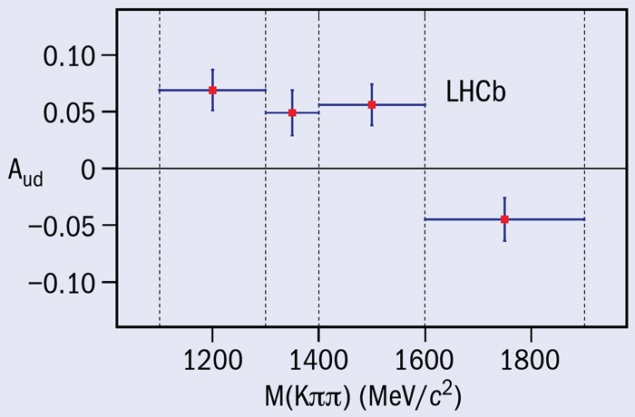
The Standard Model predicts that the photons emitted in b → sγ transitions, which can only occur through loop-level processes, are predominantly left-handed. This means that the asymmetry between the amplitudes with right- and left-handed photons – photon polarization – is close to its minimum value of –1. This quantity has never been observed in a direct measurement and remains largely unexplored. As a consequence, there still exist several extensions of the Standard Model that predict a photon polarization significantly closer to zero but have not been ruled out by other measurements of b → sγ transitions.

The LHCb collaboration has exploited B+ → K+ π–π+γ decays, which are governed by the b → sγ transition, to probe the photon polarization. The “up–down” asymmetry between the number of photons detected above and below the plane defined by the momenta of the kaon and the two pions in their centre-of-mass frame is proportional to the photon polarization. So, a measurement of a nonzero asymmetry implies observation of photon polarization. The investigation is conceptually similar to the experiment that discovered parity violation in 1957 by measuring a nonzero up–down asymmetry for the electrons emitted in the weak decay of 60Co nuclei with respect to their spin direction.

Using the full data sample collected with the LHCb detector in 2011 and 2012, the collaboration has reconstructed almost 14,000 B+ → K+ π–π+γ events. Their angular distribution has been studied in four regions of the K+ π–π+ system’s mass, where different kaon resonances and their interferences can result in different sensitivities to the photon polarization. From determination of the up–down asymmetry, Aud, in each of these mass regions, LHCb finds a combined significance with respect to the null hypothesis of 5.2σ, and therefore observes photon polarization for the first time in such decays (LHCb collaboration 2014). This important result opens the door to the future determination of the value of the polarization of the photon, which will provide a strong new test of the validity of the Standard Model.
Further reading
LHCb collaboration 2014 arXiv:1402.6852 [hep-ex], submitted to Phys. Rev. Lett.








